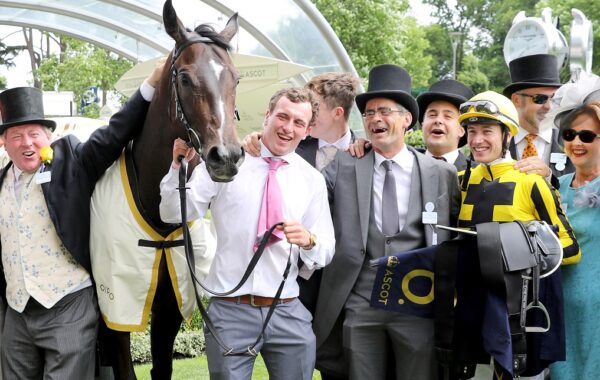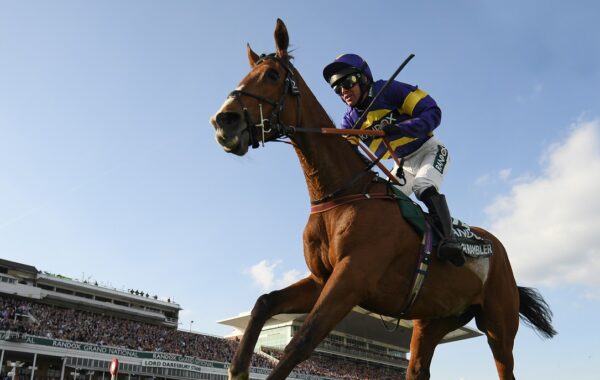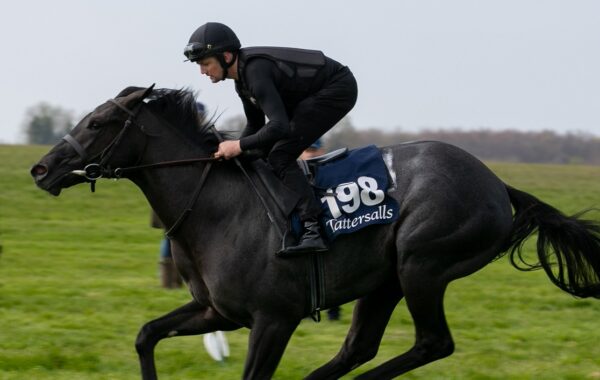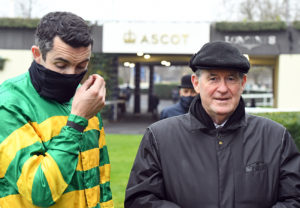Alan King is basking in the afterglow of a Flat turf season to remember. The man more readily associated with the jumping code posted a series of firsts, among them a British prize-money haul in excess of £1 million and Trueshan’s inaugural Group 1 triumph for his trainer in the Goodwood Cup.
Trueshan supplemented those gains by winning the Group 1 Prix du Cadran on Arc day, when King was an integral presence at Europe’s top table, and the Group 2 Long Distance Cup on Champions Day. It’s no wonder he is full of bonhomie as he reflects on a seminal career chapter.
“It’s been a marvellous year, obviously,” he says from his office at Barbury Castle, in Wiltshire, where he has trained for all but one of his 22 years with a licence.
“Trueshan has been a great horse for us. He had another fine season but I’m sure a lot of people were thinking he’s one of those old stayers we tend to do quite well with. So I got a lot of satisfaction from winning a Group 2 race for two-year-olds over six furlongs with Asymmetric, which is a little way from the norm for us.”
King tapers away into a chuckle at the end of the sentence, and no wonder. One can only guess what the late David ‘the Duke’ Nicholson would have made of Asymmetric’s Richmond Stakes triumph. King spent 14 years as Nicholson’s assistant at a time when Nicholson ascended to the summit of jumps racing in the mid-1990s.
Nicholson had long earmarked King to succeed him. A tempestuous, dyed-in-thewool jumping man who considered softie Flat horses the poor relatives of stores, Nicholson could never have envisaged his protégé saddling the winner of a juvenile sprint at Goodwood – which hasn’t staged a single race over jumps in its 209-year history.
Were he alive to contemplate it, Nicholson would doubtless reflect how much has changed since he handed King the licence in 1999. He was adamant King would follow on from him at Jackdaws Castle, which was owned by businessman Colin Smith, but on Nicholson’s retirement Smith sold the property to JP McManus, who duly installed Jonjo O’Neill.
King thus moved to Barbury in 2000. It was and remains an expensive property to rent and that obliged King to contemplate how to meet his financial obligations. “I couldn’t afford to have the place empty through the summer months,” he relates. “I don’t like summer jumping; never have, but I had to do something. That’s why we started out on the Flat.”
That particular career curve rose slowly until 2008, when King saddled a personal best tally 23 winners, only for the curve to retreat. Come 2012 and his annual haul of Flat winners descended into single figures, since when the curve resumed its upward trajectory. So much so that in the last few years his Flat horses have earned almost as much as his larger string of jumpers, which have struggled to match the deeds of their predecessors.
The reasons for this are well established. “When it comes to spending power at the boutique jumping sales we’ve been found wanting for some time,” King says. “We can’t afford to buy at the top end and it’s been noticeable in our results.
“People wonder why the Irish are doing so well at Cheltenham but they have been buying all the top lots at these boutique sales for the last four or five years. We are seeing the consequences of that.”
This gives rise to a sea-change the like of which no sane observer could possibly have foreseen. In the 1980s British owners migrated from the Flat to jump racing because they felt they couldn’t compete with the Middle Eastern potentates’ spending power. With million dollar yearlings turning out at venues like Redcar, jump racing promised a more rewarding environment for British owners.
That scenario has all but turned on its head. The buying power of jump racing’s biggest owners now ensures them a monopoly of the best young prospects, which have already advertised their prowess ahead of their sale by winning a point-to-point in Ireland or races in France.
On the Flat, the vast majority of horses change hands as yearlings or at breeze-up sales, where the true extent of their merit remains unknown. King believes he now has better prospects of buying a decent Flat horse than a decent jumper for the same money.
“There is more chance of that happening on the Flat,” King says. “That’s why we have gone down that route. As things stand my string is 60-40 in favour of jumpers but the gap is narrowing every year.
“With [bloodstock agent] Anthony Bromley, who buys 90 per cent of my horses, we have increasingly got stuck into the breeze-up sales,” King continues.
“Hopefully we will do that again next spring because it has worked very well for us. If an owner came to me today with a hundred grand to spend on any kind of horse, I’d be pushing them down the breeze-up route.”
The breeze-up route is where King and Bromley sourced Trueshan, for whom they gave 31,000 guineas at Tattersalls in 2018. The horse’s stamina-laden pedigree was such that King doubtless had one eye on a future career over hurdles, yet Trueshan proved so adept on the Flat that he never switched codes.
The same could never be said of Asymmetric, a son of Showcasing whose dam and granddam were sprinters. The colt was sent to King after he failed to make a six-figure reserve at Tattersalls earlier this year. There was never going to be the fallback of a career over hurdles had Asymmetric failed to cut it on the Flat.
That’s why the colt’s resounding Richmond Stakes triumph meant so much to King. “It wasn’t so much that we had anything to prove,” he reflects, “it was just satisfying to have gone and done it.
“To be fair, we hadn’t had that kind of [Flat] ammunition before. And not long afterwards we had a five-furlong winner at Sandown, which again was fairly unique for us. It showed that we can get the job done given the right ammunition. It gave us a real buzz.”
With Asymmetric’s Richmond Stakes triumph coming two days after Trueshan had won the Goodwood Cup, King returned from Sussex with a sense of being rebranded. He has won 15 races at the Cheltenham Festival, among them the Champion Hurdle and Champion Chase, but he doesn’t hesitate when asked whether his Pattern-race Goodwood double meant as much.
“Yes, absolutely,” the 55-year-old says. “Perhaps even more of a buzz because it was something new again, and it helps to get your name out there. I think it gave my career a bit of impetus, too. A few more jumps owners have come to me since then.”
For all that, King’s love for the winter code remains unadulterated. It has been tough for him since prices paid for the best young prospects skyrocketed early in the new millennium. He was left feeling impotent when he could no longer compete, with the consequence that he has not won a Grade 1 race since Sceau Royal landed the Henry VIII Novices’ Chase four years ago.
There have been times when frustration overwhelmed him. In February 2008 he took Voy Por Ustedes to Newbury for the Game Spirit Chase ahead of that horse’s bid to win the Champion Chase for the second year running. Voy Por Ustedes was then a seven-year-old in his prime who’d been with King for more than three years.
In the Game Spirit, however, Voy Por Ustedes was routed by Master Minded, a costly, young, recent import from France who’d only just joined Paul Nicholls. The futility of bashing his head against a brick wall got the better of King, whose venting of his spleen in the winner’s enclosure was denounced as unsportsmanlike.
King quickly repented, although the incident underlined his intensely competitive streak. And while that will never subside, he has adjusted his mindset to accommodate the new reality. The best young prospects are beyond his reach.
Sceau Royal remains the mainstay of his jumping string, as evidenced by a recent quickfire double over hurdles embracing the Grade 2 Elite Hurdle at Wincanton. There are enough young horses with potential for King to anticipate a rewarding season ahead.
“It was very important that we made a good start to the new season, which we did,” he says. “We have well over 100 jumpers for the season. We’re probably lacking the Grade 1 horses we had a few years ago but I think we’ve got one or two pretty smart novice chasers in the group.”
As one of the few genuinely dual purpose trainers in business, he also benefits from a change of scenery with the change in codes. “It’s something we look forward to,” he says. “I have always got excited in spring when the Classic trials start, and when we get to November we’ve had our fill of the Flat and are ready to get the proper jumpers going again.”
It’s a similar story for the staff, who all muck in with the Flat and NH horses in an integrated set-up. With horses on their hands 12 months a year, staff can take holidays when they want, rather than just in the summer months. And there is no five-month off-season when they are enrolled against their will to steam-clean boxes and repaint the yard.
Barbury Castle is about the only place you’ll ever see staying chasers leading raw two-year-olds in their work on the gallops. “I have one barn for the two-year-olds but otherwise the horses are all in it together,” King says.
“The two-year-olds go out with the jumpers and we wouldn’t train them an awful lot differently. They never go beyond seven furlongs and some of these old three-mile chasers can give the two-year-olds a good lead. If the two-year-olds can work well with them, you know you’ve got something quite useful.”
It’s good to see the spring back in King’s step after his exploits on the Flat. “We are enjoying it,” he avers. “We have a smashing team of staff but we’re ready for a holiday, having not had one for two years. We’re hoping to disappear to the Maldives in January for a couple of weeks to recharge.”
When you venture that King’s Flat prize-money haul affords him the opportunity to extend the early-evening clink of cocktail glasses from one hour to two, he laughs and says: “We would probably have done that anyway.”
Jumping stars that put the stable on the map

My Way De Solzen
and Robert Thornton
win the 2007 Arkle
Challenge Trophy at
Cheltenham
Alan King is responsible for one of the most extraordinary achievements in Cheltenham Festival history. In 2006 he won the Stayers’ Hurdle over an extended three miles with My Way De Solzen, whom he then saddled 12 months later to win the Arkle Chase over the minimum trip. It was an audacious double-strike, although perhaps not quite as maximal as it sounds.
“My Way was very much a soft ground horse,” King reflects. “In 2007 I walked the course on the Sunday before racing and it was proper heavy, so we decided to run him in the Arkle on the Tuesday. His other options were later in the week, but it’s a good job we ran him when we did because the ground was nearly quick by the end of it.”
King remembers My Way De Solzen with great affection, saying: “He wasn’t as tough as [Champion Chase winner] Voy Por Ustedes but he was more talented. If I could have put My Way’s head into Voy Por’s body I would have had the ultimate racehorse.”
For all that, King’s most accomplished Cheltenham Festival winner has to be the 2008 Champion Hurdle winner Katchit, who required 14 starts on the Flat to break his maiden before his transfer to Barbury.
“When we bought him we had no idea what he would go on to do,” King reminisces of Katchit. “He wasn’t very big, and when he won a £15,000 race at Market Rasen on his third start for us I thought to myself: ‘Job done.’
“After that he never stopped improving. The sight of a flight of hurdles transformed him from an ordinary Flat horse to an absolutely top-class jumper. We were incredibly lucky to have him.”






